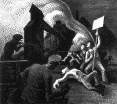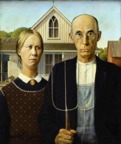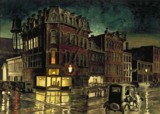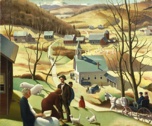
Examples:

Martin Lewis (American, 1881-1962), Boss of the Block, c. 1939, aquatint and etching, Library of Congress, Washington, DC.
Edward Hopper (American, 1882-1967), People in the Sun, 1960, oil on canvas, 40 3/8 x 40 5/8 inches (102.6 x 103.5 cm), National Museum of American Art, Washington, DC. See Ashcan school.

Thomas Hart Benton (American, 1889-1975), Mine Strike, lithograph.

Grant Wood (American, 1892-1942), American Gothic, 1930, oil on beaver board, 74.3 x 62.4 cm, Art Institute of Chicago. See American Gothic.

Charles Burchfield (American, 1893-1967), Rainy Night, 1929-30, watercolor over pencil on paper, 30 x 42 inches (76.2 x 106.7 cm), San Diego Museum of Art, CA. The subject is a street scene in Buffalo, NY.

Paul Starrett Sample (American, 1896-1974), Beaver Meadow, 1939, oil on canvas, Hood Museum of Art, Dartmouth College, NH. A small town in New Hampshire.

John Steuart Curry (American, 1897-1946), Valley of the Wisconsin, 1946, oil on canvas, 37 1/2 x 59 1/2 inches, Kemper Museum of Contemporary Art, Kansas City, MO. See landscape.
Alexandre Hogue (American, 1898-1994)
Jerry Bywaters (American, 1906-)
Also see social realism.
https://inform.quest/_art